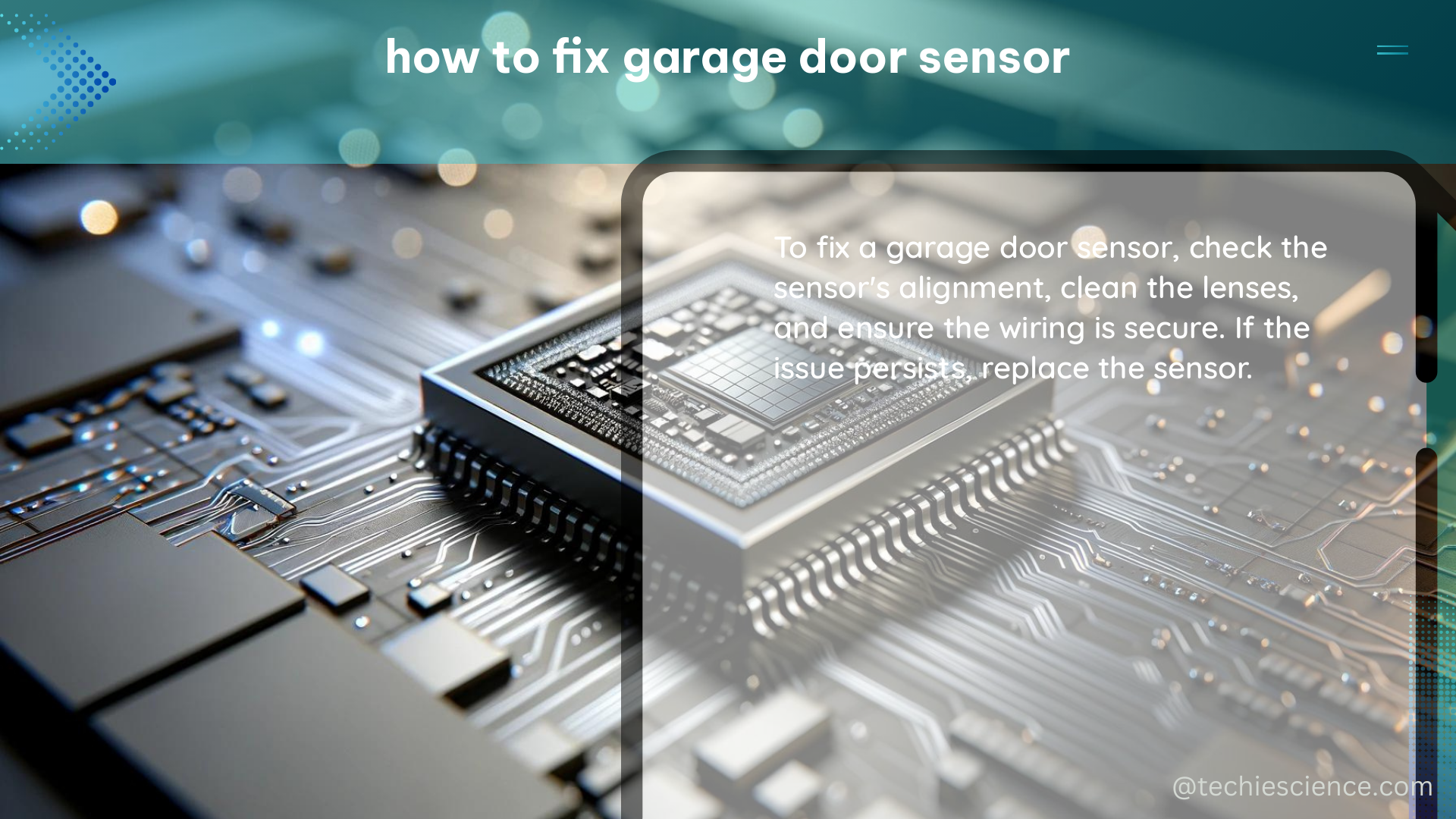Garage door sensors are an essential safety feature that prevent the door from closing if an object or person is in the way. However, these sensors can sometimes malfunction, causing the garage door to behave erratically or refuse to close altogether. In this comprehensive guide, we’ll walk you through the step-by-step process of diagnosing and fixing common garage door sensor issues, equipping you with the knowledge and tools needed to tackle this task like a pro.
Identifying Sensor Misalignment
The first step in fixing a garage door sensor is to check for misalignment. Garage door sensors work by transmitting an invisible beam of infrared light between two sensors, and if this beam is disrupted, the door will not close. To check for misalignment, look at the lights on the sensors:
- One sensor should have a solid green light, indicating it is transmitting the infrared beam.
- The other sensor should have a solid red light, indicating it is receiving the beam.
- If the red light is blinking, it means the sensors are misaligned and the beam is not being properly received.
Adjusting Sensor Alignment

If the sensors are misaligned, you’ll need to adjust their positioning to restore proper alignment. Here’s how to do it:
- Locate the two sensors, which are typically mounted on either side of the garage door opening, about 4-6 inches off the ground.
- Gently loosen the mounting screws on one of the sensors, being careful not to disconnect the wiring.
- Slowly move the sensor left or right, up or down, until the red light on the receiving sensor stops blinking and becomes solid.
- Tighten the mounting screws to secure the sensor in its new position.
- Repeat steps 2-4 for the other sensor, adjusting it until both lights are solid.
Cleaning the Sensors
Dust, dirt, and debris can also interfere with the sensor’s ability to transmit and receive the infrared beam. To clean the sensors:
- Unplug the garage door opener from the power source.
- Gently wipe the lenses of both sensors with a soft, clean cloth.
- If the lenses are particularly dirty, you can use a small amount of isopropyl alcohol on the cloth to help remove any stubborn grime.
- Avoid using any abrasive cleaners or materials, as this could damage the sensor lenses.
Troubleshooting Sensor Wiring
If the sensors are properly aligned and clean, but the garage door still isn’t functioning correctly, the issue may be with the wiring. Here’s how to troubleshoot the sensor wiring:
- Unplug the garage door opener and locate the sensor wiring, which typically runs along the wall or ceiling to the motor unit.
- Inspect the wiring for any signs of damage, such as fraying, cuts, or loose connections.
- Use a multimeter to test the continuity of the wiring. The reading should be close to 0 ohms, indicating a complete circuit.
- If the wiring is damaged, you’ll need to replace the affected section. Splice in new wire using wire nuts and secure the connections.
- If the wiring checks out, the issue may be with the sensor itself, and you may need to replace one or both sensors.
Sensor Placement and Positioning
The proper placement and positioning of the garage door sensors is crucial for their reliable operation. Here are some key guidelines to follow:
- The sensors should be installed 4-6 inches off the ground, with the transmitter and receiver directly across from each other.
- Ensure the sensors are level and parallel to the ground, using a level tool to adjust their positioning as needed.
- Avoid installing the sensors in direct sunlight, as the infrared beam can be disrupted by bright light.
- Keep the sensor lenses clean and free of obstructions, such as cobwebs, leaves, or other debris.
Sensor Replacement
If, after following all the troubleshooting steps, the garage door sensors still aren’t functioning properly, it may be time to replace them. Garage door sensor kits are widely available at hardware stores and home improvement centers, and the replacement process is relatively straightforward:
- Disconnect the old sensors from the wiring and remove them from their mounting brackets.
- Install the new sensors in the same location, ensuring they are properly aligned and level.
- Connect the new sensor wiring to the existing garage door opener wiring, matching the colors or polarity as indicated.
- Test the new sensors by blocking the infrared beam and verifying that the door won’t close.
By following these comprehensive steps, you’ll be able to diagnose and fix most common garage door sensor issues, keeping your garage door operating safely and reliably. Remember to always prioritize safety when working on any garage door components, and don’t hesitate to consult a professional if you’re unsure about any part of the process.
References
- How to Troubleshoot Garage Door Sensors
- Garage Door Sensor Troubleshooting Guide
- Solving the Garage Door Opener Safety Sensor Problem

The lambdageeks.com Core SME Team is a group of experienced subject matter experts from diverse scientific and technical fields including Physics, Chemistry, Technology,Electronics & Electrical Engineering, Automotive, Mechanical Engineering. Our team collaborates to create high-quality, well-researched articles on a wide range of science and technology topics for the lambdageeks.com website.
All Our Senior SME are having more than 7 Years of experience in the respective fields . They are either Working Industry Professionals or assocaited With different Universities. Refer Our Authors Page to get to know About our Core SMEs.